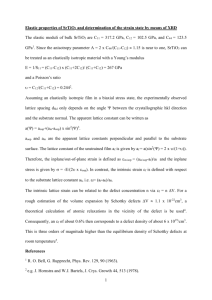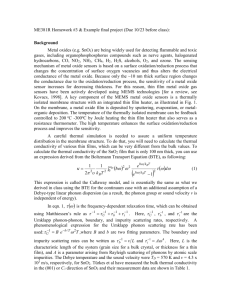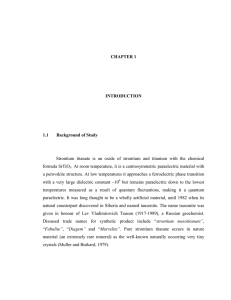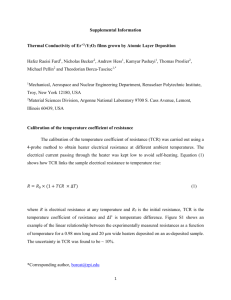TC_SrTiO3_sup_150706
advertisement
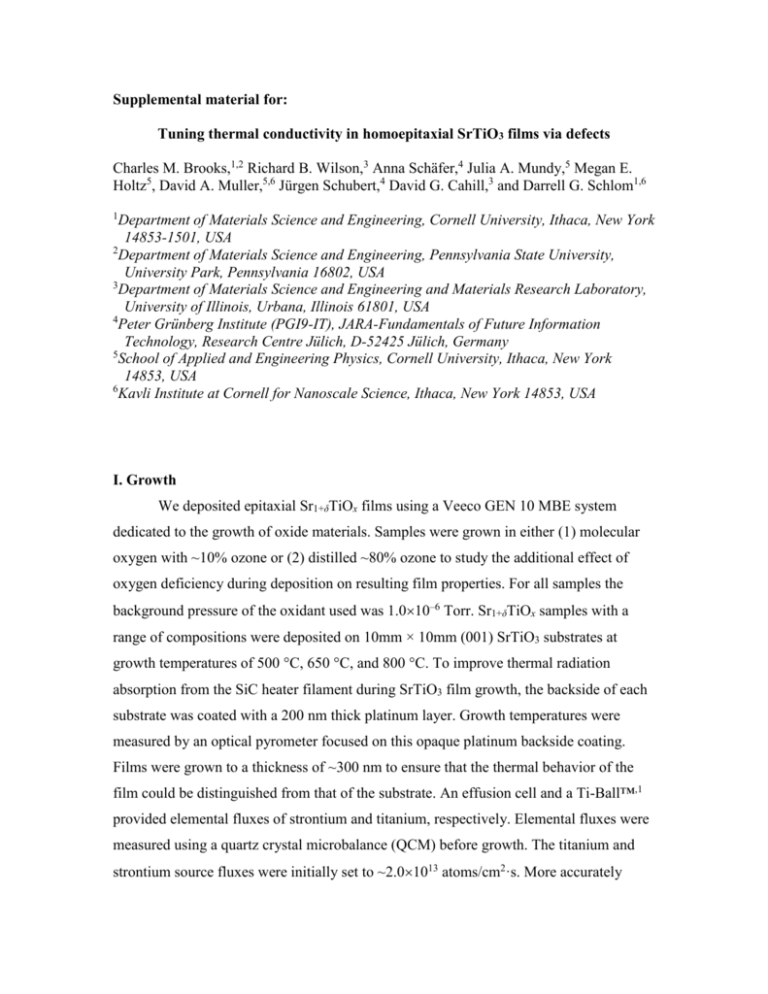
Supplemental material for: Tuning thermal conductivity in homoepitaxial SrTiO3 films via defects Charles M. Brooks,1,2 Richard B. Wilson,3 Anna Schäfer,4 Julia A. Mundy,5 Megan E. Holtz5, David A. Muller,5,6 Jürgen Schubert,4 David G. Cahill,3 and Darrell G. Schlom1,6 1 Department of Materials Science and Engineering, Cornell University, Ithaca, New York 14853-1501, USA 2 Department of Materials Science and Engineering, Pennsylvania State University, University Park, Pennsylvania 16802, USA 3 Department of Materials Science and Engineering and Materials Research Laboratory, University of Illinois, Urbana, Illinois 61801, USA 4 Peter Grünberg Institute (PGI9-IT), JARA-Fundamentals of Future Information Technology, Research Centre Jülich, D-52425 Jülich, Germany 5 School of Applied and Engineering Physics, Cornell University, Ithaca, New York 14853, USA 6 Kavli Institute at Cornell for Nanoscale Science, Ithaca, New York 14853, USA I. Growth We deposited epitaxial Sr1+δTiOx films using a Veeco GEN 10 MBE system dedicated to the growth of oxide materials. Samples were grown in either (1) molecular oxygen with ~10% ozone or (2) distilled ~80% ozone to study the additional effect of oxygen deficiency during deposition on resulting film properties. For all samples the background pressure of the oxidant used was 1.010–6 Torr. Sr1+δTiOx samples with a range of compositions were deposited on 10mm × 10mm (001) SrTiO3 substrates at growth temperatures of 500 °C, 650 °C, and 800 °C. To improve thermal radiation absorption from the SiC heater filament during SrTiO3 film growth, the backside of each substrate was coated with a 200 nm thick platinum layer. Growth temperatures were measured by an optical pyrometer focused on this opaque platinum backside coating. Films were grown to a thickness of ~300 nm to ensure that the thermal behavior of the film could be distinguished from that of the substrate. An effusion cell and a Ti-Ball™,1 provided elemental fluxes of strontium and titanium, respectively. Elemental fluxes were measured using a quartz crystal microbalance (QCM) before growth. The titanium and strontium source fluxes were initially set to ~2.01013 atoms/cm2·s. More accurately matched strontium and titanium fluxes were then achieved by fine-tuning the strontium source temperature while monitoring high-energy electron diffraction (RHEED) oscillations.2 We adjusted the strontium flux to achieve the desired film composition while depositing with both sources simultaneously during film growth, i.e., codeposition. These source fluxes correspond to a Sr1+δTiOx film growth rate of ~7.4 Å/min. The film growth time was set to incorporate 750 monolayers of TiO2 while the strontium content varies depending on the strontium flux. II. Measurement Rutherford backscattering spectrometry (RBS) using He+ ions with an energy of 1.4 MeV was employed to determine the cation composition of the codeposited Sr1+δTiOx films. For X-ray diffraction (XRD) measurements we used Cu K1 radiation from a highresolution Philips X’Pert Pro MRD diffractometer with a PreFix hybrid monochromator on the incident side and triple axis/rocking curve attachment on the diffracted side to assess the structural ordering of the films and determine the out-of-plane lattice constant. The presence, density, and orientation of RP planar faults was investigated by crosssectional bright field scanning transmission electron microscopy (BF-STEM) using a 200 keV FEI Tecnai F20-ST scanning transmission electron microscope. We measured the thermal conductivity of the films along the direction perpendicular to the (001) SrTiO3 substrate surface (k33), referred to as the longitudinal thermal conductivity,3 by time-domain thermoreflectance (TDTR).4 The TDTR measurement involved the deposition of an aluminum layer to serve as an optical transducer. Two 5 mm × 5 mm pieces were cut from each 10 mm × 10 mm sample to compare the as-deposited versus annealed thermal conductivity and avoid any complications arising from the anneal at the sample and aluminum layer interface. 1 C. D. Theis and D. G. Schlom, J. Vac. Sci. Technol. A 14, 2677-2679 (1996). J. H. Haeni, C. D. Theis, and D. G. Schlom, J. Electroceram. 4, 385-391 (2000). 3 Note that the specific coefficient of the thermal conductivity tensor being measured is k33, corresponding to the coefficient describing the heat flow parallel to the direction of the applied temperature gradient (both are along the direction perpendicular to the substrate surface). This nomenclature is analogous to the definition of “longitudinal stress,” “longitudinal strain,” “longitudinal piezoelectric effect,” and analogous tensor 2 quantities. See for example, J.F. Nye, Physical Properties of Crystals: Their Representation by Tensors and Matrices (Oxford University Press, 1957, 1985) pp. 127, 144. 4 D-W. Oh, J. Ravichandran, C-W. Liang, W. Siemons, B. Jalan, C. M. Brooks, M. Huijben, D. G. Schlom, S. Stemmer, L. W. Martin, A. Majumdar, R. Ramesh, and D. G. Cahill, Appl. Phys. Lett. 98, 221904 (2011).
